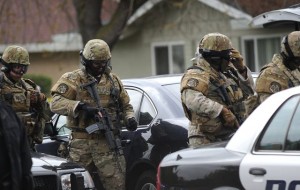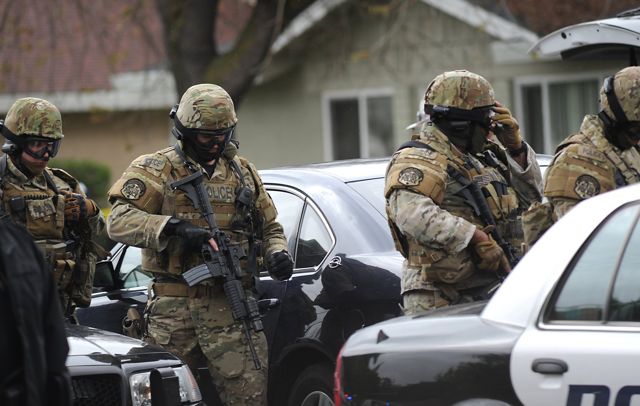 Has watching television made people afraid of crime?
Has watching television made people afraid of crime?
A new study found that Americans’ answer to one of the long-running questions in a Gallup poll – are you afraid to walk alone in your neighborhood at night? – may be influenced by the amount of violence shown on television dramas.
The study, by researchers at the Annenberg Public Policy Center of the University of Pennsylvania, found that the American public’s fear of crime is statistically related to the amount of violence portrayed on prime-time TV.
Published in the online journal Media and Communication, the study compared annual changes in the amount of violence portrayed on popular prime-time broadcast dramas from 1972 through 2010 with changes in national rates of response to the Gallup poll question over that period.
Even though the actual crime rate has fallen, according to FBI statistics, the study found that TV violence has increased since the late 1990s. The public’s fear of crime, as assessed by the Gallup annual crime survey, has also begun to rise again since that time.
“We now have stronger evidence that the fictional treatment of crime on TV may influence the public’s fears of crime,” said Dan Romer, co-author of the study and an associate director of the Annenberg Public Policy Center (APPC).
TV violence rising since 1996
APPC researchers studied violent sequences in 475 hours of commercial-free nighttime broadcast dramas, which included a heavy representation of police, legal, and medical shows. The researchers found – even after factoring out changes in FBI crime rates and people’s perceptions of change in crime rates – that the poll results fell and rose along with TV violence.
The number of violent sequences per TV hour fell from a high of 6.5 in 1972 to 1.4 in 1996, and then increased to 3.7 in 2010. Each additional violent sequence per hour predicted an increase of 1 percentage point in the people who told Gallup they were afraid of walking alone at night in their neighborhood.
“The findings are consistent with media scholarship in the 1960s and ’70s that predicted effects of fictional TV violence on audiences,” said Patrick E. Jamieson, the lead author of the study and director of APPC’s Adolescent Risk Communication Institute. “That prediction has been controversial, but with the present results, we have the best evidence to date that TV shows can affect how safe the public feels.”
The study is grounded in cultivation theory, which holds that prolonged exposure to television violence creates fear of crime and a view of the world as a dangerous place. The late George Gerbner, dean of the Annenberg School for Communication at the University of Pennsylvania, and his colleagues called this phenomenon the “mean world syndrome.” The present findings confirm the effects of TV on people’s fear but do not support the idea that people think there is actually more crime in their neighborhood.
In fact, the portrayal of violence on television was unrelated to the actual crime rates measured by the FBI. But the amount of TV violence did closely track people’s fear of crime, as seen in the answer to the Gallup question: “Is there any area near where you live – that is, within a mile – where you would be afraid to walk alone at night?”
‘Kojak’ to ‘Trapper John M.D.’ to ‘CSI: Crime Scene Investigation’
The TV sample was based on APPC’s Coding of Health and Media Project, or CHAMP, the largest analysis that has been conducted of health-risk portrayals on television. The sampled shows came from the top 30 prime-time network TV dramas. Those included “Kojak” and “Hawaii Five-O” from the 1970s; “Hill Street Blues” and “Trapper John M.D.” from the ’80s; “Law & Order” and “ER” from the ’90s, and “CSI: Crime Scene Investigation” and “House M.D.” from the ’00s. For a list of the sampled TV shows by year, go to http://www.youthmediarisk.org/TV/TopGross.aspx. The study did not include non-drama TV shows, cable TV shows, or online programs.
The shows were watched by trained coders who logged acts of violence. The study did not differentiate between different types of violence – for example, stranger vs. family or an attack vs. an act of self-defense.
“The findings suggest that TV drama may ‘transport’ viewers emotionally into the imagined world of TV shows in a way that creates fear of crime beyond the influence of the national violent crime rate or the reported perception of local crime,” Jamieson said.
[poll random]








I’m bothered more by the crime that’s going on in Washington D.C. concerning the amount of the Federal deficit that’s being inflicted on all of us. Well, those of us with jobs and who pay taxes anyway….
What a crock of crap. If only we could force kids into your religion and be able to beat them like you used to…why then morels would be better.
You’re one sick cookie.
You don’t have to watch TV to get a fear of crime, it’s in the news daily, in the town you live in, and sometimes right next door. As a whole, this countries morality has been going down since the 60’s, when they took prayer out of schools and discipline away from parents.
@Allen-most of it is due to illegal drug use.
What an unadulterated pile of doggy doo doo.
@Linda Poo-Yes, you are.
What an elementary school response. Grow up LVS
@teacher-You grow up too. TROLL.
The militarization of the police has been going on for 20 years. Primarily due to the misguided war on some drugs.